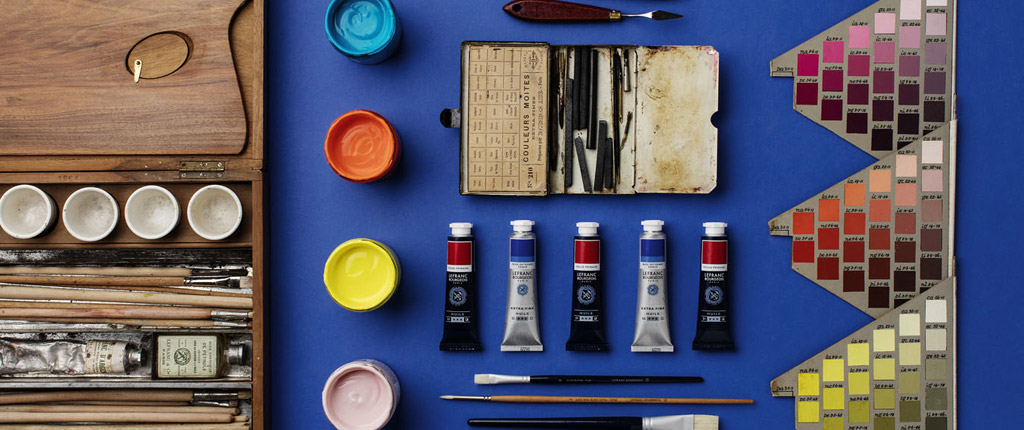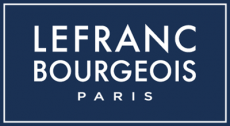
1720
The middle-class hold the economic capacity and the cities are proud of their know-how, the artists start to travel.
The masters’ workshops and their apprentices gradually disappear and the first art schools are created. Artists no longer have apprentices to prepare their pigments and binders. Chardin decides to ask a tradesman supplier to prepare his colours. , an ancestor of the Lefranc family, runs a business selling pigments and spices in Saint Germain in Paris. A close relationship is established with the artists : the fine arts industry is born.
Alexandre Lefranc
He played an important role in the colours and varnish industry.
Scientific research and analyses analysis of old paintings have resulted in the removal of dangerous and unstable raw materials, antimony white, which tended to yellow, biiodide of mercury (scarlet red), which turned black, orpiment (glazing gold yellow) which changed the tone of the metal-based colours, the highly transient and poisonous arsenic disulphide (ruby red), which altered the tone of blends, iron and cobalt cyanide salt (Prussian green), which was highly toxic and turned into an ugly tone of greyish red. Before Prussian blue was discovered, indigo was blended with smalt, chalk and starch that were bound by a rice flour mucilage to give a marvelous colour but with poor setting qualities.
XIXth century
For nearly 3 centuries, Lefranc & Bourgeois uses its skills and know-how to provide artists with innovative products.
But all these recipes needed to be redefined.
From 1889 to this day, the principles required to achieve the quality required for the fine arts are indicated on our tubes:
– Chemical composition of the colours
– Setting qualities when exposed to light
– Lightfasness (1 to 3 stars)
– Stability in blends (the M indicates that the colour can be mixed with any other colour)
1859
The English then decided to put their paints in tin tubes. As our old price lists show, paints in tubes cost one penny more than paints in bladders.
In 1859, Lefranc marketed the first tightly sealed tubes. This predecessor of the screw cap was a major innovation and had a marked impact on painting. It was at this time that the first landscape artists appeared, followed by the Impressionists.
The Impressionnists
The new approach to art that the Impressionists developed is still admired today, both in terms of their optical appreciation (juxtaposing of coloured strokes) and colour (capturing natural outdoor light). The conservation of many of their works is a real problem for restorers.
As is explained in many books on the topic (for example, Xavier de Langlais who developed the famous egg-based mat medium), Impressionists introduced mattness into their works and used oil paints in ways that were not permitted by accepted practices of the time. They diluted their paints with excessive quantities of solvents, applied them to highly absorbent canvasses and did not varnish their pictures.
The results were disastrous, as the lead-based flake white, the only opaque white paint available at the time, turned black when it came into contact with the sulphur in the atmosphere.
Bourgeois: 1867
After discovering a means of extracting alizarin to develop alizarin lacquer, Joseph Bourgeois Aine set up a paint shop in Paris, then a factory in Montreuil sous Bois where he produced the first “non-dangerous” colours. Bourgeois was greatly interested in democratising the practice of painting and commercialised the first primary colours designed for schools. The quality of his products rapidly made him a serious competitor for Lefranc.
XXth century
Then followed a series of inventions in the development of colours that are today used on every artist’s easel palette.
Our Naples yellow prompted a letter of congratulations from the artist J-F Millet, which is reproduced in the attachment.
Lefranc discovered lacquers extracted from natural madder in Strasbourg during the 1870 war with Prussia.
Cadmium green appeared in 1911, followed by the bold Saphire blue in 1913, whose tone is in perfect harmony with Cobalt blue, Ultramarine blue and Ceruleum blue. Cadmium red and green, famous for their opacity and unequalled resistance to light, appeared the same year.
In 1922, Titanium white appeared, offering the same covering power as Flake white.
In 1950, a range of transparent colours was developed specially for glazing.
Raoul Dufy experimentation : 1937
Marc Havel, chief engineer at the laboratory with a passion and a genius for art, was contacted by Raoul Dufy in 1937, who was planning to produce the biggest painting in the world. The “Fée Electricité” was made up of 250 panels measuring 1.5m by 2m.
He was faced with the problem of producing this monumental painting as quickly as possible.
The idea was to combine oil paints with an emulsion-type medium (hide glue diluted in water mixed with oil colours and 10% Dammar gum) so that fresh layers could be painted on one another, while maintaining both transparency and mattness and allowing the core layers to dry correctly. This painting has been perfectly preserved and can be admired in the Paris Museum of Modern Art.
Flashe, the first modern paint in Europe : 1955
After developing the Flemish and Venetian mediums, Bourgeois launched the first vinyl paint: Flashe. This paint introduced artists to all the advantages of aqueous phase synthetic emulsions, for their quality of adherence to a variety of supports, their instantaneous drying, their great lightfastness, together with a velvety texture and unrivalled matt colours.
1965
Merger of Lefranc and Bourgeois, who set up business in Mans in 1966.

